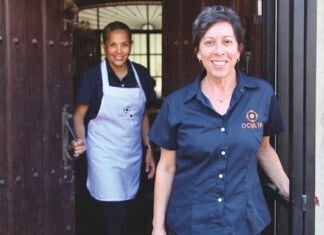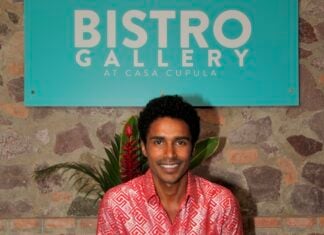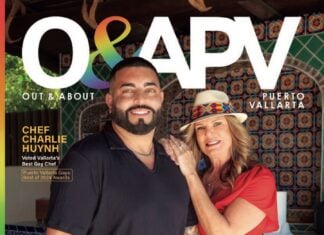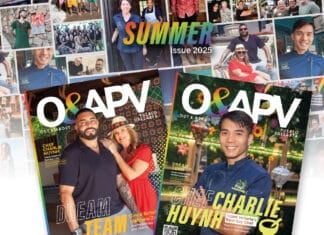Esta publicación también está disponible en: English Español
Editor’s Note: This article was originally published in 8/2018. We are reposting it today (4/1/2019) as we celebrate the life and the art of Francine Peters, who passed away over the weekend.
Story by Joseph Brant/Photos by Derek Carkner
When Francine Peters arrived in Puerto Vallarta seven years ago, she left Fred Peters back in her native Canada.
“I became Francine when I crossed the border,” she said. “Full time. Fully committed.”
At the close of a 35-year marriage, Fred was presented an opportunity for reinvention, partly borne of personal interest and partly as an expression of respect to his ex-wife. “She came home one day, dropped her briefcase on the counter, and said ‘honey, I don’t need a roommate called Francine, but I’ve never seen you happier—so I suggest maybe you live your life as Francine.’”
The marriage was a trusting and open one. For years Fred experimented as Francine, his wife fully aware. “I told her on our third date that I want to be Francine,” she explained to me. “Back then, in the 1970s, I wasn’t allowed to be me. I was in my mid-50s when it happened.”
Francine and I agreed to meet at Dee’s on Rodolfo Gomez for coffee. It was an uncommonly cloudy and rainy morning in mid-July. The moment we sat down outside, a street musician unpacked his guitar no more than ten feet away and, with no electric amplification, immediately he drowned our conversation. It was beautiful music, and he was oblivious to our discussion or our intentions, so we politely rounded the corner to Salud Super Food and continued there.
“I never wanted her to feel humiliated, accidentally bumping into me,” Francine said regarding her ex-wife, and her own decision to leave home and move to Mexico. “Vancouver is a big city but you can always bump into each other and I never wanted to put her through that, so I thought ‘well, where am I gonna go?’ and then I came here.”
She credits her former wife for providing the initial support and audacity to pursue painting as a profession. “I was a trucker and a construction worker. I built highways, and then I just got tired of drinking and gambling and working in camps up north. I needed a hobby, so I started to paint and draw. A year later, my wife says ‘give it a shot. Give it a year. I know you can always start a company or go back to your old job but try it as an artist.’ And I took it very seriously.”
Success followed. To this day, a “Fred Peters” design is used on souvenir items at the Nanaimo Museum in British Columbia. “I’m blown away that they can still sell a ton of my artwork through their swag. And I’m still their Diana Krall of the art world. Diana Krall grew up in Nanaimo. She became a famous singer and I became a famous artist. I did that painting for them and never considered licensing. I said ‘don’t pay me a penny, what ever you earn is for the museum.’ And now fifteen, twenty years later? I still support the museum in my hometown?! That’s pretty cool.”
Fred was so successful, in fact, that his professional transition to Francine has been slow moving. For the last five years, Francine reluctantly signed each piece intended for the Canadian market “F. Peters.” Later this year, the very first “Francine Peters” paintings will debut in Canada. It required a number of conversations with her long-time agent, Denise Bezanson.
“I told her, ‘I can’t sign ‘F. Peters’ anymore. I’m not F. Peters. I’m Francine. And if you’re worried about losing your clientele, I’m sorry but I can’t do it.’ And she finally accepted. She said, ‘you’re right.’”
“That’s huge for me. It legitimizes me.”
Her eyes lit up then, quickly, as she looked over my shoulder. She noticed someone walking down the hill on Olas Altas, about to pass by us on the outside patio at Salud. An old friend, another longtime resident was walking his dog in the midday. He smiled and stopped for a moment to chat, wished Francine a belated happy birthday.
“I love when that happens!” she said, turning back to me as he and the dog walked away.
“That doesn’t happen in Canada, or Vancouver, anymore,” she said. “Mexico can bring you out of your shell. I was terrified of coming here. I heard it was so Catholic, that I wouldn’t be accepted here. Well, I’ve done it! And now they tell me, ‘Boy you’re lucky!’ Oh, it is NOT luck, honey! You have no idea the courage and the chutzpah it took to do this.”
“This country is very accepting,” she continued. “The people are so warm. You smile, say ‘buen dia’ and they just light up. It makes life worth living. My paintings are much happier than they used to be. They always were colorful. I just feel better and happier.”
Francine is a self-taught painter and she learned soon after she began to seriously invest in art as a profession that it was of ironic benefit to her career development. Gallery owners in southern British Columbia are inundated with young artists who inquire about exhibition opportunities and, according to Francine, one in particular had grown weary of seeing familiar creative styles over the years.
“This fella says to me, ‘You. You are unique,’” she recalled. “’You’re still all over the map, though. You need a style that we can rely on in order to reliably promote you and sell you.’ So I asked, how do I get a style? and he said, ‘keep painting. It’ll hit you one day.’ It was quite a while later, but one day it clicked. It just clicked. And I was like, ‘this is it!’”
Though she appreciates there are more specialized terms to define her style, she prefers one word over all the others: whimsical. “Technically it’s probably expressionist, maybe impressionist,” she said. “I just tell people, whimsical. I’ve met so many couples here, tourists, where she loves abstract, he loves tonalist. And to her my work is abstract and colorful, and to him, he can recognize a real place, and they both love it!”
Just then, again, someone approached us from the street, stopped to say hello. She leaned in with a huge smile as he walked away, moments later, and repeated, “I just love when that happens!” I realized in that moment that I wasn’t writing about an artist as much as someone who’s fallen in love with this community.
“My first week here, seven years ago, I met a few people,” she said. “They turned out to be my best friends in the world. I would go to the bar and I’m Francine, I’m cross dressed and I’m sitting there and people wanted to talk to me. They were smiling. And then a couple nights later I went back as Fred. It was too hot. I couldn’t be bothered. I just wanted to go for a cold beer. The bar owner as I’m leaving the bar goes, ‘leave Fred at home. Bring Francine. You can do it here. We’re all here to support you.’”
“And even now,” she continued, “I can sit anywhere, like here, and someone will say ‘excuse me. Can I ask you a personal question? I apologize, but what would I call you?’ I say, ‘well, I’m Francine, but I know what you’re asking and I don’t know the answer. I don’t know and I don’t care. I’m just Francine.’ The world wants to put me in a box. Transexual. Transgender. Pansexual. There are so many cubby holes. I just tell people I’m Francine.”
By this time, nearly an hour had passed. We packed our things and strolled down Olas Altas and then Basilio Badillo. It was a busy day, midweek, the sidewalks crowded a little more than usual. Or maybe not. I found myself acutely aware of the strangers, the looks—some intense, others less so—as we walked and continued the conversation, nonchalant. Francine did not flinch, did not break her stride or her train of thought.
“I don’t mind helping people understand who want to understand,” she said. “It also helps me. Because I honestly don’t understand everything. I’ve been in therapy most of my life, trying to figure this—to figure me out! I’ve apparently broken the mold in the trans women world quite a bit, I’ve been told, because I’m not frilly enough. I’m the butchest trans woman you’ll ever meet! But you only live once. And I’m very blessed. I got to live two lives in one. I’m extremely blessed. I know people like me who have lost everything, their jobs, their careers, their family, everything. Their lives! I haven’t. I don’t know why. I’m so special in that respect, so I’m just gonna go with it.”
I asked about the future, as I have for each of the artists profiled here in this issue. Francine’s reply was a significant deviation.
“No idea. I stopped making plans,” she said. “I live day by day. I have no idea where I’m gonna be, what I’m gonna do. I had my whole life planned out and it didn’t work out that way. I hope I’m still here, I hope I’m healthy, I hope I’m happy. I hope I’m still an artist. I hope I still have all my friends here.”
“What else could you want?”
Esta publicación también está disponible en: English Español

















